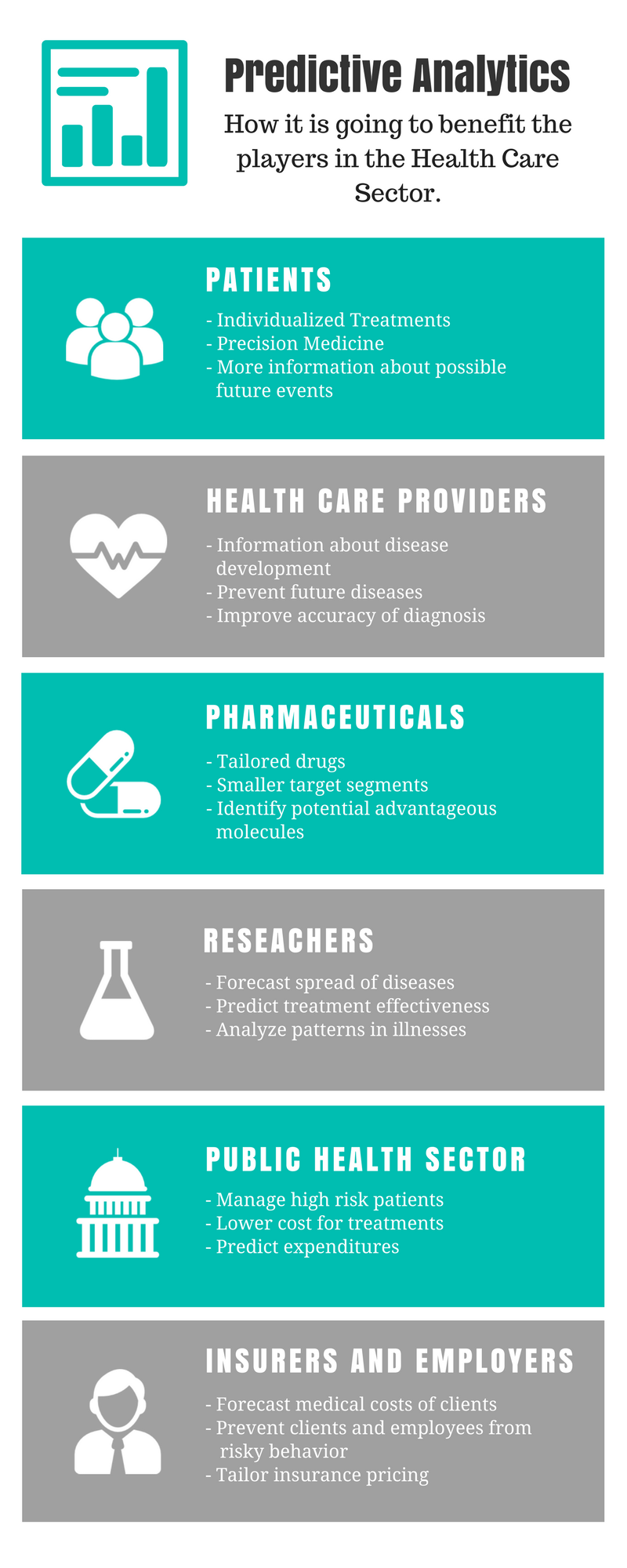
Predictive analytics has been around as long as data has been available on this planet. It’s been widely applied in several industries already, but the Health Care sector has long been characterized by a lack of data due to paper-based processes and verbal interaction between physicians and patients. But with new trends such as the increased use of EHR (Electronic Health Records), IoT and wearable devices, data gathered in this industry is growing rapidly, providing a suitable basis for analysis and great opportunities for improvements of health care in the future.
What is predictive analytics?
Predictive analytics is the practice of using historical data to make predictions about the future or future unknown events. Drawing on many different techniques such as data mining, statistics, time series modeling, regression analysis, machine learning and artificial intelligence, predictive analytics can draw patterns and recognize trends from existing data sets. In this way it can be used to forecast likely behavior of individuals or machinery and assess future probabilities, risks and outcomes with an acceptable level of reliability.
Spreading predictive analytics with growing data
Although deeply rooted in several industries (e.g. in banking to determine creditworthiness of clients), the practice of predictive analytics is spreading to each and every industry alongside the rise of big data systems and growth of data points and data sizes. With the progress in IoT, connected devices and sensor technologies, every moving individual and machine is constantly producing data that more and more companies can use to gain predictive insights.
The latest industries to jump on the predictive analytics train are the automotive industry and the health care sector. While OEMs are starting to us data to predict maintenance of car parts and tires as well as accidents, predictive analytics in the health care sector is just about to take off.
Predictive analytics in Health Care
The health care sector has not historically been an innovative and data driven industry. Through new players and technological developments that is, however, changing dramatically. There are two big trends driving the rise in big data creation in this sector:
-
Growing use of electronic health records. According to SK&A, a leading US reference information platform, around 67% of all health care providers in the US used at least basic electronic health records in 2017. Although this number is far from 100% it represents a rise of over 25% in five years, up from 40% in 2012. Together with the increasing number of electronic records, the amount of data collected in hospitals is also growing strongly.
- IoT and smart devices. With the rise of IoT and developments in sensor technologies, new devices and wearables are entering the market, allowing patients to track their health and record a broad variety of physical data such as blood pressure and heart rate. In many cases also available to supervising doctors, these data sets can be used for broader analysis.
Due to these trends patients, companies and other organizations in the health care space are looking towards a future of data abundance in the Health Care sector that provides the perfect basis for predictive analytics.
How things are going to improve
Large amounts of raw data do not provide value in themselves. The methods and focus of predictive analytics determine how the data can serve different players in the space. Here’s how predictive analytics is going to improve things for each of those stakeholders:
For patients:
Patients will benefit strongly from predictive analytics. Individuals will receive treatments and medications that exactly fit their individual characteristics, symptoms and clinical picture. This trend, strongly connected to the term precision medicine, is based on dividing patients into subpopulations that differ in the development and treatment of their conditions.
Being more informed about their health status, patients will also work hand in hand with physicians to achieve the best outcomes possible. Patients will also become aware of health risks earlier due to notifications from predictive models used by doctors or monitoring through apps, medical devices and wearables.
For health care providers:
Being provided with enough patient data including doctor’s visits, diagnoses and services provided to clients over a long period of time, health care providers start drawing conclusions about future disease development and occurrence as well as probabilities of recovery with regards to different treatments.
Thereby, they can save costs, speed up treatment and prevent future diseases from happening. With a data set large enough, predictive analytics will allow health care providers to be able to forecast heart attacks, strokes and relapses and prescribe preventive action such as special diets or physical activities. Besides that, comparing present clinical pictures with past data also improves accuracy of diagnoses.
For pharmaceuticals:
Predictive analytics will be especially valuable for pharmaceutical companies, as the industry is moving towards producing and selling specialist products used by few customers rather than blockbuster drugs sold to the masses. By taking advantage of the growing available molecular and clinical data and identifying potential advantageous molecules, predictive analytics could help develop new and effective drugs tailored to certain target groups.
For researchers:
Researchers can also take advantage of the growing data sets to analyze developments or spread of diseases and forecast how new medicine or technological developments might help cure or prevent illness. Predictive analytics is already used heavily in the analysis of cancer and tumor mutations to identify which mutations are the most dangerous and develop ways to stop exactly those first. While application of data analytics in this area just started, there is great potential to solve major human health challenges in the future.
For public health:
Preventive health care and early measures against potential future diseases will not only help patients but may also dramatically lower expenditure of the public sector on health care. Through joint collaborations with health care providers and investments in monitoring and discovering high risk patients, costs for cure and treatments can be proactively managed.
For health care insurers and employers:
Last but not least, insurers or employers providing healthcare benefits for employees can take advantage of predictive analytic algorithms to gain forecasts of future medical costs. At the same time, by synchronizing data among each other, health care providers, employers and insurers can subsequently also develop health plans that prevent employees from risky behavior.
Summing up, predictive analytics can serve any of the stakeholders in the health care industry. If barriers to information transparency and synchronization of data points within and between the all parties can be overcome, the health care industry can look forward to a bright future of individualized high-quality services for patients at low costs.
See the infographic below for a visual sum-up!

